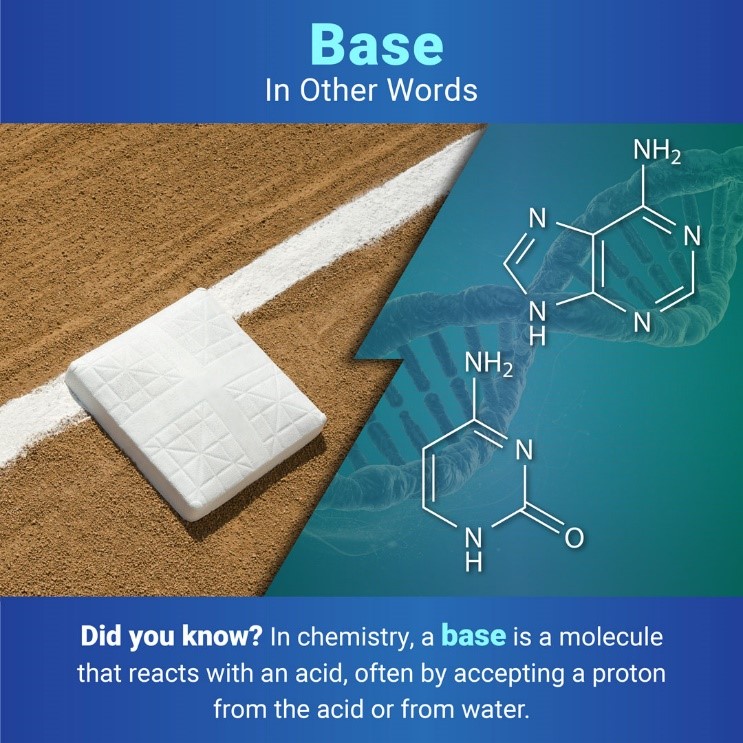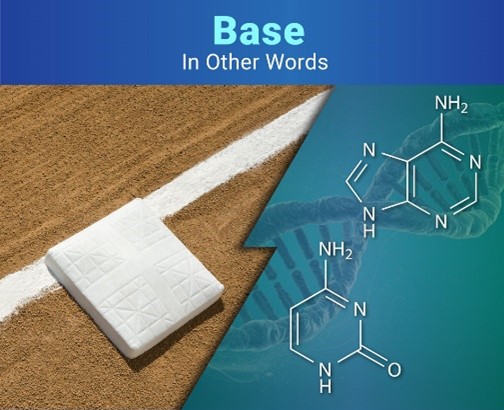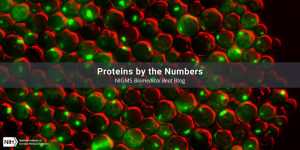You might first think about sports when you hear the word base, but not all bases are on the baseball diamond. In chemistry, a base is a molecule that reacts with an acid, often by accepting a proton from the acid or from water. Baking soda and dish soap are common bases.

A Building Block for Life
Bases are found throughout biological systems and in many molecules critical to life. The pH scale measures how acidic or basic (“alkaline”) liquids, such as water or blood, are. Liquids with a pH less than 7 are acidic, while liquids with a pH greater than 7 are basic. Electrolytes, like sodium, calcium, and magnesium, are acids or bases that work to tightly regulate the pH of the blood in the body. If the pH of blood increases or decreases from the normal 7.4, many important systems in the body can’t function optimally.
One group of molecules that contains bases is nucleotides. A nucleotide consists of a five-sided sugar molecule, a chain of one or more high-energy molecular structures called phosphate groups, and one of the following two bases:
- Pyrimidine. The three pyrimidine bases contain a six-sided ring structure and are called cytosine (C), thymine (T), and uracil (U).
- Purine. The two purine bases contain a six-sided ring structure connected to a five-sided ring structure and are called adenine (A) and guanine (G).
Nucleotides are the building blocks that make up the nucleic acids DNA and RNA. Specific sequences of A, G, T, and C within DNA provide the blueprints for building proteins, large molecules that are needed for virtually every process in our bodies. During protein production, the information coded in DNA is translated into RNA as specific sequences of A, G, U, and C.
One of the most powerful nucleotides is adenosine triphosphate (ATP). ATP contains the purine base adenine, the sugar ribose, and three high-energy phosphate groups. In a chemical reaction, one or more of these phosphate groups are removed to release large amounts of energy needed to power hundreds of different cellular reactions.
Related Medicines
Medicines that are composed of, mimic, or target bases can treat a variety of conditions. Antacids are bases that neutralize stomach acid and can help treat acid reflux and indigestion. Additionally, researchers have developed several classes of medicines that target nucleotides. Health care professionals prescribe them to treat:
- Viral infections. Medicines for controlling some viral infections, such as HIV and COVID-19, pose as nucleotides. When a virus incorporates the nucleotide mimic into a DNA or RNA molecule that it’s building, the molecule’s growth is halted because the next nucleotide can’t be added properly. Without complete DNA or RNA molecules, the virus can’t multiply and infect more cells.
- Cancer. Purine mimics are used to treat certain types of cancer. Like antiviral medicines, these work as mimics to stop DNA and RNA synthesis and kill cancer cells.
- Multiple sclerosis (MS). Pyrimidine synthesis inhibitors block the creation of pyrimidine bases and stop the replication of cells involved in the inappropriate destruction of the central nervous system that occurs in MS.
The next time you see someone running the bases, think about the hardworking bases inside their body keeping it balanced and giving them the energy to run.
If you think of another word that means one thing in everyday conversation and something else in science, let us know in the comments below. We might feature it in a future blog post!







